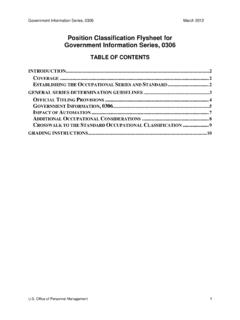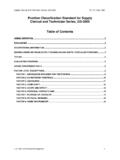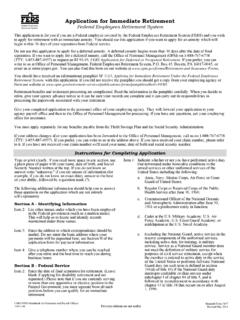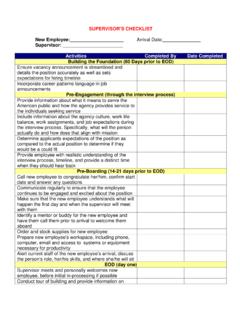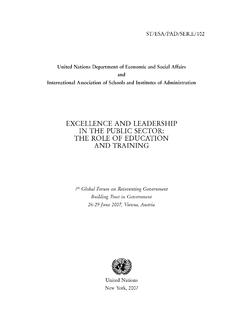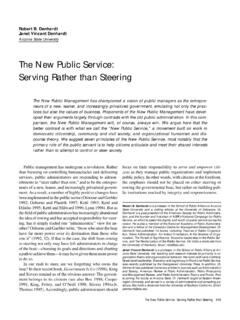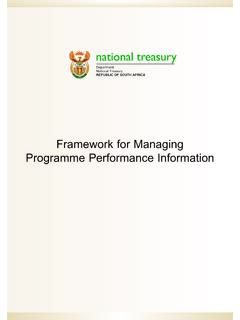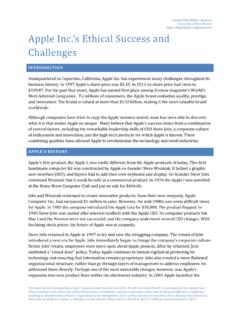Transcription of OWR-09 WorkVio. Man USE! 3 - United States Office of ...
1 W o r k p l a c eiolencedealing withUnited StatesOffice ofPersonnelManagementOffice of Workforce RelationsOWR-09 February 1998a Guide forAgency PlannersAGuide forAgency PlannersFOREWORDP reventing workplace violence is a growing concern in the United States . Public interest andmedia attention have focused primarily on dramatic but very rare types of violence such asshootings by disgruntled employees in Office buildings. Planners of workplace violence programsface the dual challenge of reducing employees anxiety about very rare risk factors while focusingtheir attention on more likely sources of danger. Undue anxiety about the Office gunman canstand in the way of identifying more significant, but less dramatic, risk factors such as poorlylighted parking lots or gaps in employee training programs. This anxiety can also make it moredifficult to cope with one of the most common workplace violence problems the employeewhose language or behavior frightens employees in organizations such as the National Institute for Occupational Safety andHealth and the Occupational Safety and Health Administration have played a leading role inhelping employers recognize and respond appropriately to the actual risks of workplace violencefaced by their employees.
2 At the same time, the risk of violence against Federal employeesthemselves has received increased attention, particularly in response to the tragic loss of life in theterrorist bombing of the Alfred P. Murrah Federal Building in Oklahoma City in 1995. For manyFederal workers, the anti- government sentiment they had handled on the job for years suddenlyacquired a new and terrifying before the Oklahoma City tragedy, Federal managers and specialists, like their private sectorcounterparts, were becoming aware of the dangers of workplace violence and concerned aboutdeveloping preventive programs for their employees. This was a challenging theyturned to the private sector for expert guidance, they often found advice that was not necessarilycompatible with Federal laws and regulations, or that failed to cover issues faced by Federalemployees. However, in attempting to develop their own programs, agencies often discovered thatthey lacked the expertise necessary for a truly comprehensive approach.
3 Depending on its mission,an agency might be rich in law enforcement personnel but without the needed resources in mentalhealth or other disciplines whose input was the spirit of reinventing government , the Office of Personnel Management organized theInteragency Working Group on Violence in the Workplace. The purpose was to bring together amulti-disciplinary group of experienced professionals from throughout the Federal government inorder to develop comprehensive approaches to analyzing and responding to threats or incidents ofviolence in the Federal workplace. This document is a product of the Office of PersonnelManagement and the Interagency Working with Workplace ViolenceACKNOWLEDGMENTSThis handbook reflects the contributions of experts from many professions and many Federalagencies. The Office of Personnel Management (OPM) wishes to thank all those who contributedto the development of the handbook. We especially appreciate the assistance given by theDepartment of Justice and the General Services Administration s Federal Protective Service onissues concerning law enforcement and security.
4 Special thanks also go to the individuals listedbelow whose willingness to share their expertise, experience, and talents enabled OPM to developguidance that provides answers to some of the most difficult questions about handling potentiallyviolent Basye, Federal Protective ServiceGary Beard, Federal Protective ServiceBernard Beidel, House of RepresentativesThomas Bresson, Smithsonian InstitutionDonna Byler, Department of ArmyCathleen Civiello, , Department of DefenseScott Cooper, Esq., Department of JusticeBen Elliott, Department of JusticeRobert L. Eufemia, , government Printing OfficeYvonne Fair, Department of NavyRobert A. Fein, , ConsultantCynthia Field, ConsultantMichael Gelles, , Naval Criminal Investigative ServiceLauretta Grier, Department of Housing and Urban DevelopmentLana Katz, American Federation of government Employees, retiredMark Maggio, Federal Judicial CenterPeter McCauley, Internal Revenue Service, retiredMichael McClure, Department of ArmyRandi Mendelsohn, Federal Emergency Management AgencyLloyd Reese, Department of Veterans Affairs, retiredMilagro Rodriguez, American Federation of government EmployeesEugene Rugala, Federal Bureau of InvestigationLisa Teems, Department of Health and Human ServicesBryan Vossekuil, Secret ServiceJanice Walker, Department of NavyPatricia Willman, Department of InteriorJohn D.
5 Zielinski, National Labor Relations BoardAGuide forAgency PlannersiINTRODUCTIONP urpose of Handbook ..1 Overview ..1 The Importance of Planning ..2 PARTI: THE BASIC STEPS OFPROGRAM DEVELOPMENTSECTION 1 PROGRAM DEVELOPMENTO verview ..7 Forming a Planning Group ..7 Working with Your Union ..8 Steps in the Planning Process ..8 SECTION 2 DEVELOPMENTOFWRITTEN POLICYSTATEMENTA dvantages of Written Policies ..13 Policy Statement Contents ..13 Recommended Approaches ..14 SECTION 3 PREVENTIONO verview ..17 Warning Signs of Violence ..17 Training ..18 Pre-Employment Screening ..22 Security Measures ..22 Using Alternative Dispute Resolution (ADR) as a Preventive Strategy ..23 PARTII: CASE STUDIESI ntroduction ..29 Basic Concepts ..29 How to Use the Case Studies ..30 Case Study 1 - AShooting..32 Case Study 2 - Viciously Beating and Wounding a Coworker ..35 Case Study 3 - ASuicide Attempt ..38 Case Study 4 - Stalking ..40 Case Study 5 - ADomestic Violence Situation.
6 43 Case Study 6 - AThreat ..46 Case Study 7 - Veiled Threats ..49 Case Study 8 - AThreat ..54 TABLE OF CONTENTSD ealing with Workplace ViolenceiiPARTII: CASE STUDIES (continued)Case Study 9 - AThreat Made During an EAPC ounseling Session ..56 Case Study 10 - Threats Made By an Ex-Employee58 Case Study 11 - Threats From Non-Employees ..61 Case Study 12 - Intimidation ..63 Case Study 13 - Intimidation ..65 Case Study 14 - Frightening Behavior ..68 Case Study 15 - Frightening Behavior ..70 Case Study 16 - Disruptive Behavior ..73 PARTIII: BACKGROUND INFORMATIONSECTION 1 FACTFINDING/INVESTIGATINGI ntroduction ..79 Types of Investigations ..80 Administrative Investigations ..80 Preparation and Procedures in Administrative Investigations ..82 Interview Techniques ..86 Other Considerations for the Agency Planning Group89 SECTION 2 THREATASSESSMENTI ntroduction ..91 Threat Assessment Resources ..92 Excerpts from Threat Assessment: An Approach to Prevent Targeted Violence.
7 93 SECTION 3 EMPLOYEE RELATIONS CONSIDERATIONSO verview ..105 Administrative Actions to Keep an Employee Away from the Worksite ..106 Disciplinary Actions ..107 Disabilities As a Defense Against Alleged Misconduct108 Ordering and Offering Psychiatric Examinations ..109 Disability Retirement ..110 Appeals of a Disciplinary Action ..111 SECTION 4 EMPLOYEE ASSISTANCE PROGRAM CONSIDERATIONSI ntroduction ..113 Overview of the Employee Assistance Program ..113 TABLE OF CONTENTSAG uide forAgency PlannersiiiSECTION 4 EMPLOYEE ASSISTANCE PROGRAM CONSIDERATIONS (continued)The Employee Assistance Program s Role in Dealing with Workplace Violence ..114 Other EAPC onsiderations for theAgency Planning Group ..118 SECTION 5 WORKPLACE SECURITYI ntroduction ..121 Security Planning ..121 Law Enforcement and Security Assistance ..122 Physical Security Measures ..124 Physical Security in GSAO wned or Leased Buildings124 Physical Security Survey.
8 126 Computer Security ..127 Examples of Handouts ..128 SECTION 6 ORGANIZATIONALRECOVERYAFTER AN INCIDENTI ntroduction ..133 Management Steps to Help an Organization Recover133 The Critical Incident Stress Management Process ..135 Critical Incident Stress Debriefing ..136 Critical Incident Stress Defusing ..140 PARTIV: RESOURCESF ederal government Agencies ..145 Non- government Organizations ..147 Computer Systems ..149 TABLE OF CONTENTSD ealing with Workplace ViolenceivAGuide forAgency Planners1 IntroductionPurpose ofThis handbook, developed by the Office of PersonnelHandbookManagement and the Interagency Working Group on Violence in the Workplace, is the result of a cooperative effort of manyFederal agencies sharing their expertise in preventing and dealingwith workplace violence. It is intended to assist those who areresponsible for establishing workplace violence initiatives at theiragencies. However, we anticipate that its usefulness will extendwell beyond the planning phase since many of the sections provideinformation that can be helpful for managers and specialists asthey deal with difficult workplace violence situations.
9 OverviewPart I of the handbook introduces a process for developing an effective workplace violence program. It guides an agency splanning group through the basic steps of developing programs,policies, and prevention strategies. Case studiesPart II presents a set of case studies for the planning group to use in analyzing agency needs, planning programs, and trainingpersonnel to respond to workplace violence situations. The casestudies introduce a wide range of challenges an agency may face,and they provide discussion questions to help the planning groupdevelop the most effective approach to these challenges. Basic technicalPart III offers basic technical information on several areas of informationexpertise that may be involved in workplace violence purpose is to serve as a reference for planning group members as they find themselves working with colleagues whoseprofessional background is different from their own. While in noway comprehensive enough to serve as a training manual, it helpsthe planning group become more familiar with the technicallanguage, legal constraints, and other special issues that eachprofession brings to the interdisciplinary guidance is based on the collective expertise andexperience of Federal government law enforcement off i c e r s ,security specialists, criminal investigators, attorneys, employeerelations specialists, Employee Assistance Program counselors,IntroductionDealing with Workplace Violence2 Overview forensic psychologists, and union officials.
10 It consists(continued)primarily of lessons learned from many years of experiencewith actual cases involving potentially violent employees. The guidance covers not only incidents of physical violence, suchas shootings and assaults, but also the far more prevalent incidentsof intimidating, bullying, and other inappropriate behavior thatfrighten employees. It covers incidents involving employees andincidents involving individuals from outside the agencythreatening violence against agency employees. The ImportanceThe central theme which emerges from the shared experience ofof Planningthese specialists from different disciplines is this: While some cases of workplace violence can be dealt with swiftly and easilyby a manager with the assistance of just one specialist or oneoffice, most cases can be resolved far more easily and effectivelyif there is a joint effort which has been planned out in advance byspecialists from different preparedMany who have never experienced workplace violence say,Idon t need to worry about this.
